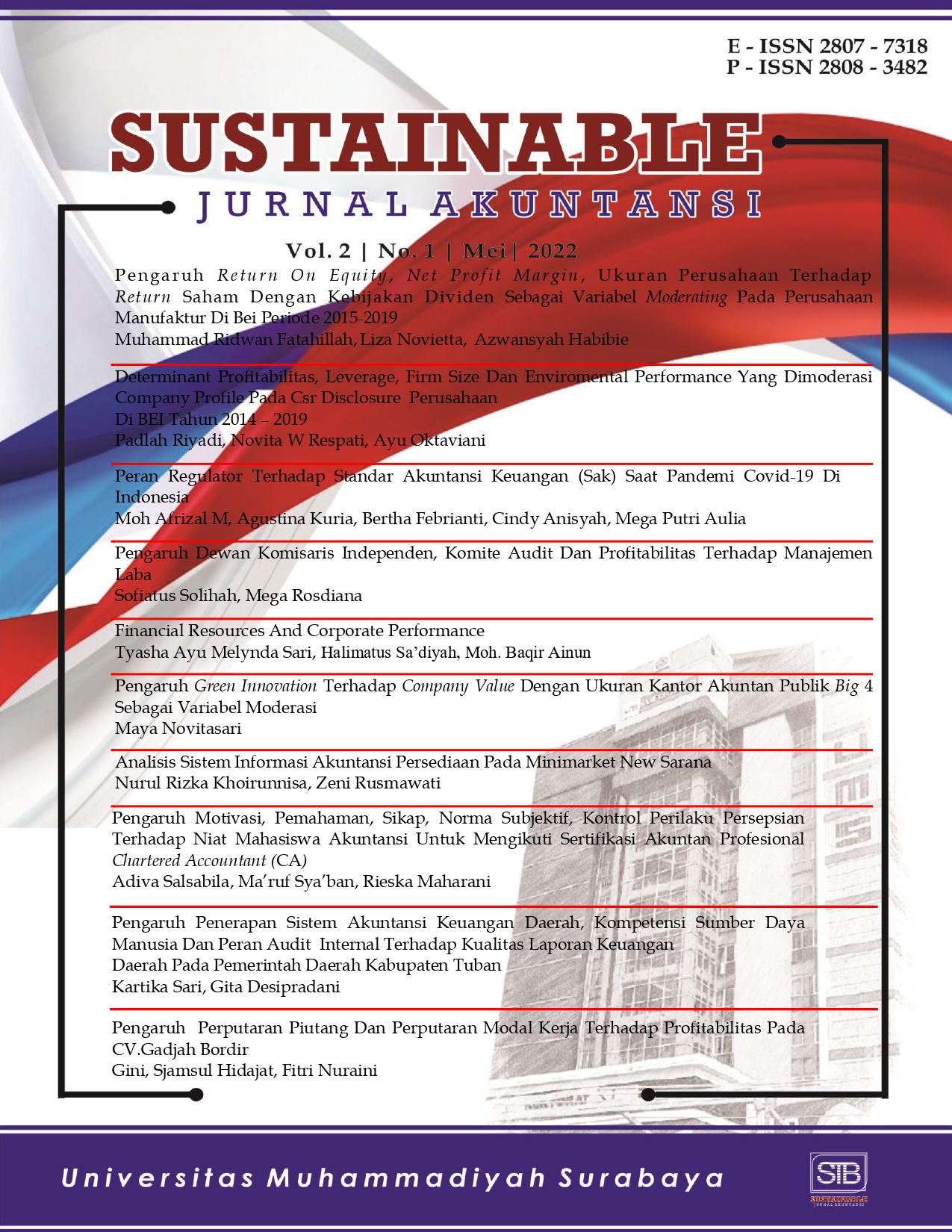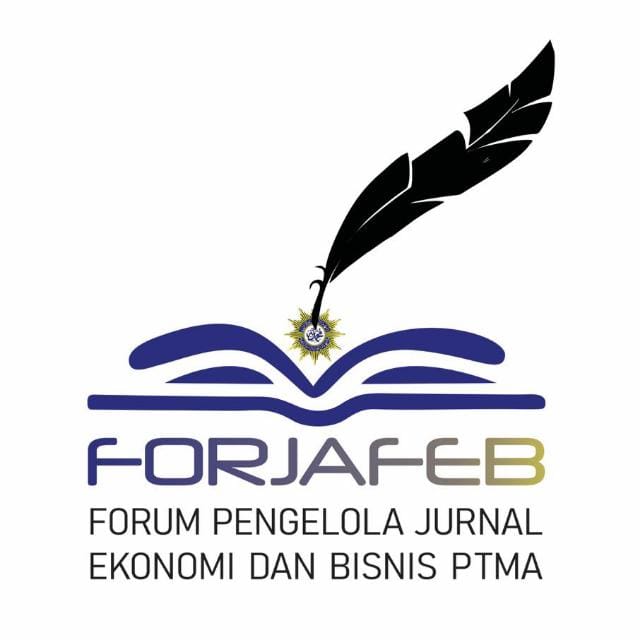Pengaruh Perputaran Piutang dan Perputaran Modal Kerja Terhadap Profitabilitas Pada CV. Gadjah Bordir
DOI:
https://doi.org/10.30651/stb.v2i1.13445Kata Kunci:
Receivable turnover, working capital turnover, profitability.Abstrak
Amid the intense business competition companies are required to be able to achieve market positions, so companies need to carry out credit sales strategies, so that sales increase. In CV Gadjah of Embroidery is a business activity. Gadjah of Embroidery requires a big cost because in the process of work, it requires costs and energy for its production. The So financial problems become a burden on CV. Gadjah of Embroidery business. The CV. Gadjah of Embroidery because its can be an obstacle to the cost of production.The purpose of the study was to determine the effect of accounts receivable and working capital turnover on profitability at CV.Gadjah of Embroidery for the period 2015-2020.The method of this study uses quantitative methods to measure the influence of accounts receivable and working capital turnover of profitability in CV. Gadjah of Embroidery, the observation period in 2015 - 2020. Hypothesis testing is using descriptive analysis method, statistical analysis method consisting of multiple linear regression analysis Simultaneous significant testing (F test), partial significance testing (Test-T) and Determination Coefficient Testing (R2). The results showed that there was an influence on the rotation of accounts on profitability in CV. Gadjah of Embroidery, while working capital turnover was an influence on profitability in CV.Gadjah of Embroidery. The Adjusted R square value = 0.666 means 66.6 percent of the influence of accounts receivable and working capital on profitability on CV. Gadjah of Embroidery. While the remaining 33.4 percent explained by other variables outside the variables used in this study.
Referensi
Agus, Sartono. 2015. ManajemenKeuangan:TeoridanAplikasi. EdisiKeempat. Yogyakarta: BPFE.
Andi Marlinah, Nurmasitah (2019). “Pengaruh Perputaran Modal Kerja Dan Perputaran Piutang Terhadap Profitabilitas Pada CV. Nonyda Makassarâ€. Jurnal Ilmiah E-ISSN 2621-4377 Vol. 17 No. 2
Anggraeni Eka Pratiwi (2019). “Pengaruh Perputaran Modal Kerja, Ukuran Perusahaan, Leverage Dan Perputaran Piutang Terhadap Profitabilitasâ€. Jurnal Ilmu dan Riset Akuntansi E-ISSN: 2460-0585 Vol. 8 No. 3
Bambang Riyanto. 2012 Dasar-dasar Pembelanjaan Perusahaan, ed. 5, BPFE YOGYAKARTA
Bangun Prakoso, Zahroh Z.A, Nila Firdausi Nuzula (2014). “Pengaruh Perputaran Modal Kerja Dan Perputaran Piutang Terhadap Profitabilitas (Studi Pada Perusahaan Pembiayaan Listing di BEI Periode 2009-2013)†Jurnal Adminitrasi Bisnis. Vol. 15 No.1
Ghozali, Imam. 2015. Aplikasi Analisis Multivariate dengan Program SPSS 22 Edisi Kelima. Semarang: Badan Penerbit Universitas Diponegoro.
Harjito, D.A dan Martono. (2014). Manajemen Keuangan. Edisi Kedua. Yogyakart: EKONOSIA. Kampus Fakultas Ekonomi Islam Indonesia.
Hery. 2017. Teori Akuntansi Pendekatan Konsep dan Analisis. Jakarta: Grasindo. Ikatan Akuntansi Keuangan. (2014). Instrument keuangan: Pengakuan dan Pengukuran. Jakarta: Salemba Empat
I Made Sudana. 2012. Manajemen Keuangan Perusahaan Teori dan Praktik. Jakarta: Erlangga
Kasmir. (2012), Analisis Laporan Keuangan. Jakarta: PT. Raja Grafindo Persada.
Mardiah, Nafisah Nurulrahmatiah (2020). “Pengaruh Perputaran Modal Kerja dan Perputaran Piutang Terhadap Profitabilitas Pada PT. Hanjaya Mandala Sampoerna Tbk.†Jurnal Ilmiah Manajemen E-ISSN: 2616-4978 Vol.11 No. 2
Mohamad Ali Wairooy (2019). “Pengaruh Perputaran Modal Kerja Dan Perputaran Persediaan Terhadap Profitabilitas (Pada Perusahaan Manufaktur Sektor Tekstil Dan Garmen Di Bursa Efek Indonesia)â€. Jurnal Ekonomi E-ISSN: 2686-5467 Vol. 15 No. 2
S. Munawir. 2014. Analisis Laporan Keuangan. Yogyakarta : Liberty
Unduhan
Diterbitkan
Terbitan
Bagian
Lisensi
Hak Cipta
Hak cipta terhadap artikel yang diterbitkan di Sustainable : Jurnal Akuntansi.
Penulis harus menyerahkan hak cipta pada jurnal dengan menandatangai dan mengirimkan form penyerahan hak cipta (template) melalui email sustainable@um-surabaya.ac.id
Penulis dapat menyebarluaskan artikelnya melalui media manapun.
Lisensi
Setiap karya yang ditulis penulis dilisensi dengan Creative Commons Attribution-NonCommercial 4.0 International License.

















